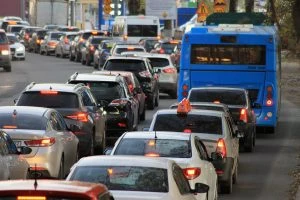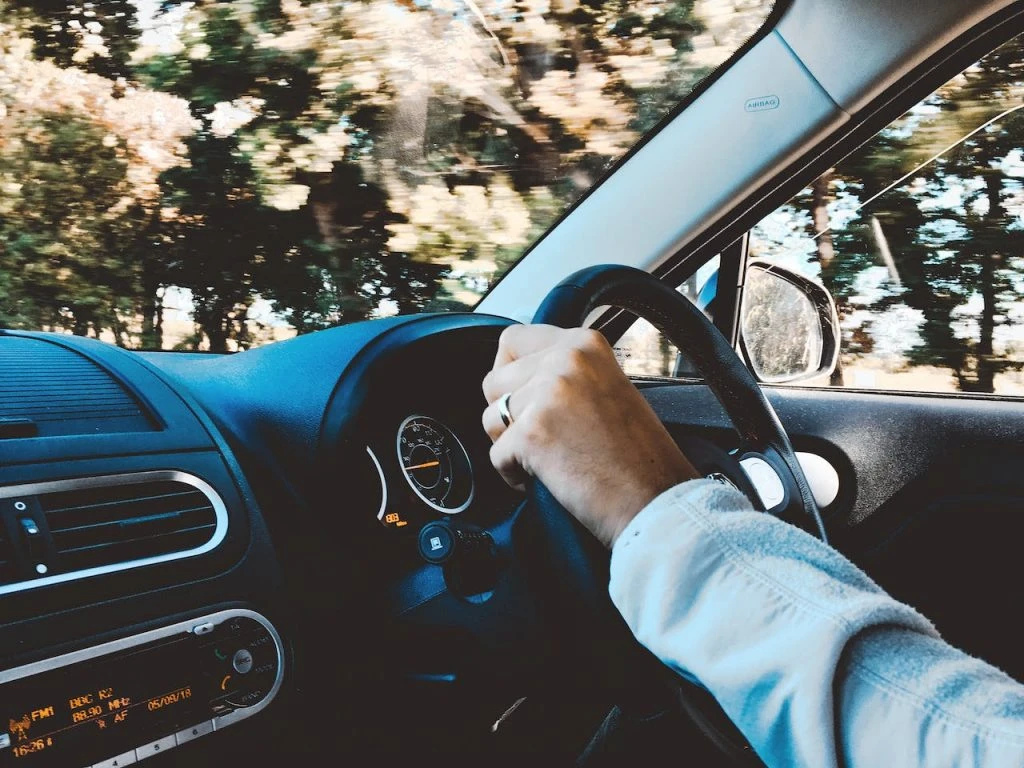Driving in Australia
Tips To Cope With Congested Traffic

We’ve all been there, locked in grid traffic. And it’s always a bit tempting to slip past slower traffic, cutting back in front to get a little closer to the next set of lights before anyone else does. Yes, you’re with me!
These sorts of tedious, testing journeys may occur every day when you’re coming back from work or going to work. Traffic jams can occur after an accident has taken place or when people are heading away for the holidays all at once. It might be the popular school run, or it could be that everyone is dispersing all at once from the stadium car park after a big win for the Green and Golds. These phases of our journeys can be made to feel a little bit easier when you have planned well in advance and if you can keep an open mind that it won’t last forever. Being a little more flexible and giving yourself more time to get to your destination means that you can breathe a little easier and relax behind the wheel.
When the roads are busy, take your time and be aware of what’s happening around you. Try and give other road users the respect they deserve, too. There are others trying just as hard as you are to do the right thing and get to work on time. Yes, and they may not be as confident behind the wheel as you, so cut them some slack and don’t cut them off! If you keep a decent gap between your car and the car in front of you, you can look ahead and see what the traffic is doing, slowing gradually to maintain a nice steady flow with fewer sharp stop and start scenarios. It also helps to negate the all too common nose to tail accidents.
The same goes for merging lanes. Problems show up when some drivers stop in the merging lane to wait for a gap. Then there are those who would rather speed up and get ahead of another car in the line. Both of these styles aren’t cool, and both styles cause the traffic flow to come to a halt. Giving each other some space and time keeps the flow moving steadily, which is really what we all want anyway.
When you’re travelling home from a lazy day at the beach, or towing your caravan, or when maybe you just want to revel in the moment and soak up the scenery by travelling along at 70–80 km/h, well, that’s cool, but do keep in mind that there are other road users that have to make an appointment or who need to get to the start of a school rehearsal. Not everyone can travel this slow below what the open road limit allows, so use those mirrors and be aware of who needs to get past you. Show them respect because you are holding them up, and they are getting more and more frustrated at being dictated by you choosing to travel at a slower pace on a perfectly good piece of road with a much faster speed limit. Pull over and let them pass as often as you can, and don’t be the cause of a crash. Especially don’t be that driver who drives slowly along the windy bits or the parts with double yellow lines, then speeds up to the limit as soon as a passing lane or a clear straight comes along.
We all need to be prepared to react to someone’s mistake, poor judgement, or poor decision, whether the roads are busy or not. Keeping ourselves fresh and aware on the road while being courteous and respectful of others helps our journeys to be safe and enjoyable.
Ideas to help you stay calm:
- Play the right sort of music through your sound system – nothing too aggro. You don’t have to listen to soothing spa music, but anything that gets you on edge should be avoided.
- Practice diaphragmatic breathing, in through the nose and out through the mouth, trying to breathe with all of your torso.
- Remind yourself that all the other drivers are probably in the same boat as you and you all want to get home or to work. Maybe smile at some of the other drivers near you.
- Put on a really enjoyable podcast or audiobook. With a really good one, you might not want the journey to end!
- If the traffic is absolutely gridlocked and doesn’t look like it’s moving soon (e.g. if the road closes after a major accident), switch off your engine if applicable and move around while you’re waiting. Or get out your phone or laptop and do what you can for work. Just be aware of when the traffic starts moving again!
What Makes the Perfect Car for a Daily Commute?
In the hustle and bustle of daily life, the significance of a reliable and comfortable vehicle for your daily commute should not be downplayed. As commuters spend a substantial amount of time on the road, the perfect car should seamlessly blend efficiency, comfort, and safety to transform the daily journey into a stress-free experience.
Efficiency
At the heart of the perfect daily commute vehicle is efficiency. A fuel-efficient engine is not only economical but also contributes to a greener environment. Cars with advanced hybrid or electric technology are gaining popularity as they provide an eco-friendly option while reducing fuel costs.
A smooth and responsive transmission system adds to the efficiency, ensuring a seamless transition through traffic without unnecessary fuel consumption.
Comfort
Comfort is a non-negotiable factor for a daily commuter. From the plushness of the seats to the interior space, the perfect car should cocoon its occupants in comfort. Ergonomically designed seats with ample lumbar support reduce fatigue during long drives.
A well-insulated cabin shields passengers from external noise, creating a serene environment.
Climate control systems that efficiently maintain a comfortable temperature, regardless of weather conditions, add an extra layer of convenience.
Connectivity and Infotainment
Modern life is intertwined with technology, and the ideal daily commute car should reflect this reality. Seamless connectivity features such as Bluetooth, Apple CarPlay, and Android Auto allow drivers to stay connected while keeping their focus on the road.
An intuitive infotainment system with a user-friendly interface ensures that controlling navigation, music, and other functions is a breeze. USB ports and wireless charging options enhance the convenience of keeping devices powered up during the commute.

Safety
Safety is paramount, and the perfect daily commute car should be equipped with a comprehensive suite of safety features. Advanced driver-assistance systems, including lane-keeping assist, adaptive cruise control, and automatic emergency braking, enhance overall safety.
A solid, well-built structure and multiple airbags provide an added layer of protection in the event of an accident. Additionally, features like blind-spot monitoring and rearview cameras contribute to a safer driving experience, especially in crowded urban environments.
Practicality and Storage
A commuter’s life often involves carrying various items, from work essentials to groceries. The perfect daily commute car should offer practical storage solutions. Ample cargo space, cleverly designed compartments, and foldable rear seats contribute to a versatile interior. A compact yet spacious design allows for easy maneuverability in city traffic while ensuring there is enough room for passengers and belongings.
Cost of Ownership
The ideal daily commute car extends its appeal beyond the initial purchase price. A low cost of ownership, including maintenance and insurance, makes it a practical choice for long-term use.
Fuel efficiency, durability, and the availability of affordable replacement parts all contribute to minimising the overall cost of owning and operating the vehicle.
Crafting the perfect car for a daily commute involves a delicate balance of efficiency, comfort, safety, and practicality. As technology continues to evolve, the ideal daily commute companion should adapt to the changing needs of modern life.
Paying For The Roads We Drive On

Across the Tasman, there are plenty of people getting annoyed at the increase in large, damaging potholes that have developed over the last few years on NZ’s tarmac road surfaces, even on main State Highways. Over there, for quite some time, EV owners have been getting a free ride on the coattails of motorists using an internal combustion engine (ICE) vehicle and who pay their fair share of road user chargers (RUCs) and/or a large portion of tax levied on the fuel at the pumps for the roading upkeep. This got me thinking about how should we be fairly introducing EVs to the masses while maintaining our roading systems? I realize it’s likely to be a bit contentious, but it’s not a question just for New Zealand’s new government to answer; it is also worth giving a bit time to thought and discussion here in Australia.
In Australia, we pay quite a lot of money into the pool of government funds that is received on yearly vehicle registrations. According to the Australian general insurance provider, GIO, the average cost for a family car is likely to be around $1240 per year. The excise tax (an indirect tax charged by government on the sale of a particular good or service) on the common fuels used in Australia (as of 1 February 2022) is $0.442 per litre. Introducing a direct road user charge as a replacement for fuel excise tax is something that has been bandied about at various high levels of government in Australia. The idea gains extra weight particularly when you consider the seemingly imminent transition from fossil-fuel and the ICE to electric vehicles (EVs).
A transition from ICE vehicles to EVs changes the maths and raises eyebrows for those harbouring the more philosophical questions involving fairness and equality for all socioeconomic groups. Without some form of direct user charge for the EV motorist, they would otherwise make no contribution to the roads’ upkeep.
If, in the future, we do end up going entirely electric, the current $12 billion or so of annual revenue from fuel tax will need to be replaced from some other scheme or source. It seems quite economically sound to simply charge for owning and using cars on a scale according to the number of kilometres driven.
Adding another aspect to your discussion on this topic down at the pub might earn you a free drink, so how about considering the damage caused to roads according to the weight of the vehicle driving over it? A UK report carried out by researchers at the University of Leeds suggested that EVs can damage roads at twice the rate of an equivalent-sized ICE vehicle. According to the data, the average EV adds 2.24 times more wear and tear to roads than an ICE vehicle of similar size. They also think that battery electric vehicles (BEVs) with a mass of over 2000 kg contribute 2.32 times the rate of road deterioration.
So could the fuel excise could be scrapped altogether, and all vehicles should be taxed via a user pays system based on the weight/mass of a vehicle? This sort of deal might actually help lower emissions in the long run because the lighter the car, the more frugal it is, EVs, hybrids, and ICEs all included. The cost of road repairs is also related to the CO2 emissions as well, so the fewer road repairs are required, the lower the emissions emitted – well, in theory anyway. What do you reckon?
Is Driving A Pain In The Neck?

Does this sound familiar? You’ve been on the road driving interstate for hours on end. You finally get to your destination but as you go to move, and it suddenly feels like someone’s driving white-hot nails into your neck or shoulder. Sometimes, this pain can come on long before you reach your destination.
This sort of thing can be one reason why some people prefer to fly rather than go on long-distance road trips. However, if you prefer to drive, as a lot of us do, and you want to see the scenery up close as you travel, then you probably want to stop the long hours of driving becoming a literal pain in the neck.
What causes neck pain when driving? Two factors are at play here. The first is that your head is kind of heavy, and your neck has to have the muscles to support it – if you’ve ever seen or held a newborn baby, you’ll know that we aren’t born with the ability to hold up our big brains inside our big heads, and these muscles have to be developed pronto. The second factor is that when driving, we tend to keep our heads and necks in more or less one position the whole time: on the road ahead, with the occasional head-check of the wing mirrors. Being forced into one position for a long time causes the muscles to cramp. I don’t know if the heads-up displays found in most modern vehicles make the problem worse or not.
The issue of support is easy enough to deal with. For a start off, adjust your headrest. Most of us know how to adjust the lumbar support (if your driver seat has this; many do) and the angle of the seat to the right position. If you don’t know how to do this properly, the idea is to have your seat back at an angle so your hips and shoulders are stacked above each other (the seat and the back should be at an angle of 90–100°). If you like to slump or slouch back, your neck will have to go at an angle it doesn’t like for long periods so you can see ahead. Fixing the angle of your seat and making sure that your lumbar support is sitting nicely in the small of your back will go a long way to avoiding neck pain while driving. Also make sure that the head rest is touching the back of your head.
However, even with the cushiest of seats in the perfect position, your neck will get tired and sore after a while. This means that you may need to take other steps during long-distance drives to avoid your neck aching.
The best tips I’ve found for avoiding neck pain while driving are the following:
- Get a neck support pillow. You might feel that you look silly wearing something that looks like you’ve just had neck surgery, but at least you’ll feel a lot more comfortable. These pillows will take some of the weight of your head so your neck doesn’t have to work so hard.
- Adjust your hand position during long drives. Yes, we all know that 10 to 2 is the best position to have your hands on the steering wheel, but keeping your arms in this position will cramp the trapezius muscles (that’s a big group of muscles in your neck and shoulder). During a long drive, change your hand positions around.
- Chill out. Many of us tend to clench our jaws and tense our shoulders when we feel stressed. This leads to agonizingly tight shoulders. As you drive (assuming that you’re not in a high-pressure situation), do a quick survey of your neck, jaw and shoulders. Are you holding your stress in these parts of your body? Do a few deep breathing exercises as you drive to help dispel the stress.
- Massage. Use self-massage (with one hand on the back of your neck), a massage seat or a helpful passenger riding shotgun to give the muscles in your shoulders and neck a quick squeeze and rub.
- Move your neck. Even while you’re driving, you can move your neck and shoulders – without taking your eyes off the road. Shrug your shoulders and try to roll them. Do that neck roll and one-sided shrug you see tough guys and gals in the movies do before a fight. Slide your neck from side to side while staying level like a belly dancer. Tilt your head from side to side like a stereotypical Indian. Nod and shake your head. As long as you keep your eyes on the road ahead, you’re all good.
- Take a break! The fact that your neck is sore is a sure sign that you’ve been sitting in one position for too long. Your legs could probably do with a break as well. Pull over and stretch your legs. As well as all the neck exercises mentioned above, remember to move your arms and do a few twists of your spine as well.
Obviously, if the traffic is heavy or if you’re driving through the middle of the city, then you may not be able to do all of these. However, do what you can when you can, and you’ll find that driving is less of a pain in the neck.